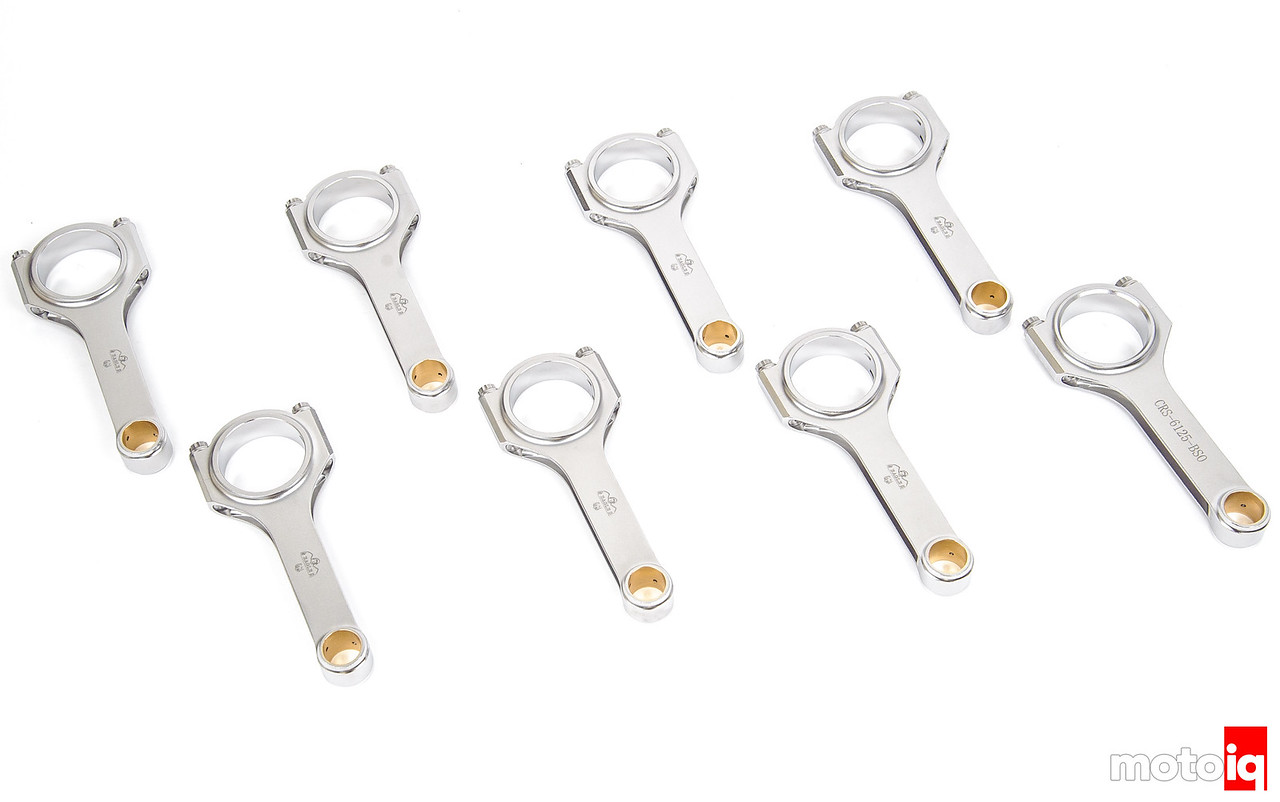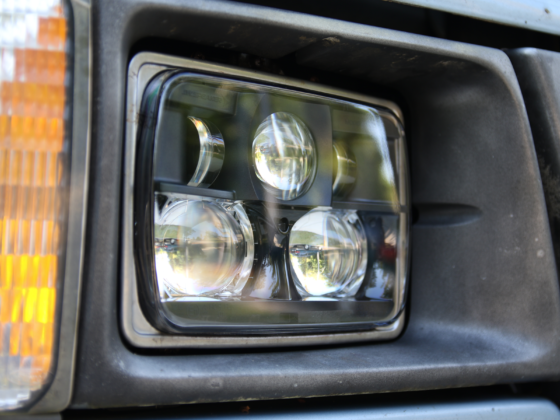
The Sikky pan with wings on the sump has 1.5 quarts more capacity at 6.5 quarts. This is important when running high volume oil pumps. The pan has handy bungs on it for an oil temperature sensor and two turbo drains. The Sikky pan has thick 1/2 rails to reduce leaks and actually stiffen the block a little.

Oil starvation is an issue with LS engines when used on drift cars that can pull serious G forces. A modern pro drift car can pull over 2.2 lateral G’s on banked turns and 1.5 g’s on flat turns. The S13 pulled 1.8 G’s in banked turns and 1.3 g’s on the flats in its heyday. This is easily more than a wet sump can handle. The Sikky Pan has vertical and horizontal baffles with one-way trap doors to help keep oil around the pump pickup.

Since LS engines are normally rear sumped with external transfer lines, we used this Sikky adaptor to bypass this where we could plumb to a remote filter.

Spinning off your harmonic balancer is never good, we used a high strength ARP balancer bolt.

To reduce Torsional vibrations in our stroked, high revving LS we turned to Fluidampr part number 760111 for one of their viscous harmonic balancers. Torsional vibration is not related to reciprocating balance as in making sure the pistons, rods, and crank are balanced to each other. Torsional vibration is the cranks whipping reaction to power impulses applied to it via the force of combustion events. The impulses applied to the crank add up to larger potentially damaging forces when the crank hits it’s natural or resonate frequency and increased harmonics of it, particularly 3rd and 4th orders as they can fall within the more stressed higher rpm ranges of operation. These large vibrations can cause engine damage like crank failure due to high cycle fatigue and bearing wear. As the whip can cause vibrations with an amplitude of over a degree in very extreme cases, it can cause spark scatter as the crank angles sensor gets whipped around. The uncontrolled fluctuations in timing that result from this can cause a loss of power and even engine damage. The whip can cause damage to belt-driven accessories like the alternator and power steering. It can also cause belt failure. So torsional whip can be bad, especially on racing engines and engines that are modified to have a longer than stock stroke like ours.
Conventional OEM harmonic dampers typically have a hub attached to the crank with a mass damper bonded to the hub with an elastomer. The weight of the mass damper is tuned to help attenuate vibrations in a certain range. A bonded rubber damper can only be tuned to work in a narrow RPM range. Sometimes an OEM will tune the damper to absorb vibrations in a lower order, lower RPM range that is bothersome in a normal cruising RPM range, not at a more destructive high RPM range. Some OEM dampers have two damping rings tuned to work at different frequencies to help get around this. The Fluidampr gets around this by being amplitude sensitive instead of frequency sensitive. A Fluidampr has a steel flywheel housed in a laser-welded housing that is attached to the crank. The housing is filled with a silicone goo that acts as a shear layer between the housing and flywheel. The silicone absorbs the torsional vibrational energy, the more the torsional movement, the more the silicone absorbs the force. This is independent of the frequency of the vibration. The silicone fluid has a constant viscosity from -40 degrees to 300 degrees with low internal friction. It also has good heat conductivity so it can dissipate the heat generated from vibrational energy well which makes it a good damping medium.
The Fluidampr also is SFI Certified for safety to their 18.1 spec. This is a specific certification for harmonic balancers and includes requirements that the outer ring cannot separate from the hub in use and that the damper can tolerate being spun at over 12,500 rpm for over an hour with no damage.




31 comments
What did you rev this engine to produce 650whp?
7200 rpm
What’s the part number for the block you used? TIA
12673475
Hello Mike
Would you able to build for me Good LSX engine for Drift?
Of course.
Of course, we can, it just takes money.
Mike, great information! I was wondering to build this engine as you did on your channel but running off regular premium gas, what modifications would I need to make? How much power loss could I expect as a result? I’m eager to get similar horsepower at the rear wheels. But I’m sure the current setup wouldn’t allow for premium gas.
You would need a lower compression ratio. You would probably lose 40 hp or so.
How much did this build cost you total ?
Price out all the parts including the block and every peice needed to have a plug and play motor. Multiply that number by 2.5 and it will be close.to actual cost.
Actually, it’s a lot less than that. The parts are expensive. Labor and machining are about $4000, WPC of most parts is about $2700
Price out all the parts including the block and every peice needed to have a plug and play motor. Multiply that number by 2.5 and it will be close.to actual cost.
Mike has $4000 plus $2700 parts = $6700
Pete’s rule of thumb parts [$2700] x 2.5 = $6750
Not too far off .
then there’s all the other stuff needed to have a runnin motor….Like Fuel ,Ign systems , ETC
There is no way the parts on this motor are only $2700! That is just the cost to WPC treat them.
What is the part number for the cam?
We don’t know, it was customer supplied and we didn’t recommend using it for drifting, not enough low end.
Will a 6.0l ls be able to use the same parts? I have a Pontiac G8 that I want to try and mimic this on.
Yes, but you won’t have quite the same displacement.
Thank you for the thorough explanation of everything. I wish more builders could/would break it all down as you have done!
hi mike, love your videos and information. can you please tell me the make and part # of the wrist pins you used in this build. thank you for your time.
Mike was $6700.00 around the actual price for plug and play
Mike said the labor, machining and WPC of most parts was $6700. That doesn’t include the cost of any of the parts. I would bet another $15000 in parts, my guess is $22000 to make it plug and play.
what about the core shift in the factory ls3 block?
what about it?
We notice some blocks are very thin on one side due to this. Some blocks are OK. Its just a cuation for people buying new blocks to do builds like this.
hello mike i am from holland and i want to build this engine for my volvo amazon 1966 project car
can i run this engine with 98 octane pump gas without race gas
or do i need to use another compresion ratio for that
i am planing to use it for street and strip use
hope you can help me
Yes you need to reduce the compression to around 11.5:1
Hi Mike. Love the content just one simple Question, Did you have the 6.2 Ls Bored over to a 6.8 liter for The Stroker kit or the stroker kit gave it the displacement to a 414 cubic inch?
It’s done with stroke, aluminum LS blocks can’t be bored out much, we said exactly what we are doing in the third paragraph, don’t be lazy, read!
Hi Mike. What oil weight do you recommend for drift ls3 with tight bearing clearances. Is 15w50 will be good choice or its too heavy ?
Thank you
Sure it is what we run.